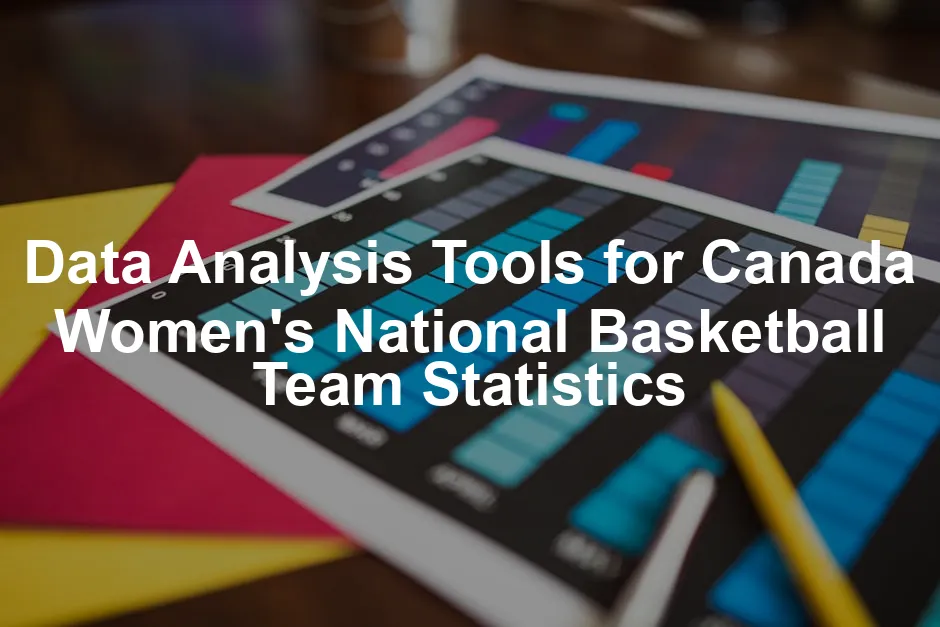Introduction
In the competitive arena of sports, data analysis tools are game-changers. For the Canada Women’s National Basketball Team, these tools are essential for turning numbers into winning strategies. With basketball evolving into a data-driven sport, teams can no longer afford to overlook the insights that statistics provide.
Understanding player performance, team dynamics, and strategic opportunities can lead to improved outcomes. This is where data analysis tools shine. They help coaches and analysts decode complex statistics, turning raw data into actionable insights. For instance, if you’re looking for a way to track player performance comprehensively, consider the KINEXON GPS Tracking Device. This device can monitor player movements, helping coaches make data-driven decisions.
For instance, imagine a coach trying to optimize game strategies. Without data, decisions would be based on gut feelings. But with data analysis tools, coaches can identify trends, strengths, and weaknesses. They can evaluate player efficiency and performance metrics, ensuring that every decision is informed.
These tools go beyond simple number crunching. They offer visualizations that make data comprehensible. Coaches can see patterns in player movements, scoring efficiency, and defensive strategies. This allows for real-time adjustments during games.
As we explore various data analysis tools available, we’ll highlight their relevance to the Canadian women’s basketball team. From performance tracking to statistical visualization, these tools are revolutionizing how the team approaches the game, both on and off the court.
In a sport where every second counts, having the right data at your fingertips can make all the difference. If you’re passionate about basketball and want to dive deeper into analytics, you might find Basketball Analytics: A Guide to Advanced Statistics a worthwhile read!

Summary of Key Points
This section will provide a thorough overview of data analysis tools specifically designed for the Canada Women’s National Basketball Team, emphasizing their importance in modern basketball.
First, we will discuss the significance of data in basketball. The integration of analytics has transformed coaching methods and player development. Statistics now play a crucial role in forming effective strategies and improving player performance.
Next, we will review popular tools utilized for data analysis and visualization. Tools like KINEXON, Hudl, and FIBA LiveStats are instrumental in gathering and interpreting crucial data that can enhance the team’s competitive edge. These platforms allow for detailed performance metrics, enabling coaches to tailor their strategies accordingly.
Additionally, real-world applications of these tools within the context of the Canadian women’s basketball team will be examined. From tracking player efficiency to analyzing game statistics, these tools provide invaluable insights that can lead to better decision-making and improved overall performance.
Finally, we will highlight future trends in sports analytics. As technology evolves, new methodologies and tools are emerging, promising to redefine how teams analyze performance. These advancements will shape the future of women’s basketball, providing even deeper insights into the game.
By the end of this article, readers will gain a comprehensive understanding of the data analysis landscape for the Canada Women’s National Basketball Team. The insights provided by these tools are not just numbers; they are the keys to unlocking better performance outcomes and fostering a winning culture.

The Evolution of Data Analysis in Basketball
Overview of Data Usage in Sports
Basketball has always been a game of numbers. From points scored to rebounds collected, statistics dictate the outcome. Early on, basketball relied on basic stats. Coaches tracked points, fouls, and turnovers. But as the game evolved, so did the data. The advent of advanced analytics changed everything.
In the 1980s, teams began to realize the importance of deeper insights. They started measuring shooting percentages and assists. Fast forward to today, data analysis is essential for success. Coaches and players now live by metrics. They analyze every aspect, from shooting efficiency to defensive strategies.

Transformation Through Technology
Technology has been the driving force behind this transformation. The introduction of tracking systems revolutionized player analytics. Wearable technology, like Wearable Fitness Trackers, monitors player movements in real-time. These tools provide invaluable insights on player health and performance.
Software platforms also play a crucial role. Coaches use sophisticated software to analyze video footage. They break down plays, identify trends, and develop strategies. This tech-savvy approach has turned data into a vital part of the game.
With the rise of big data, teams can now access a wealth of information. Advanced metrics, such as Player Efficiency Rating (PER) and Win Shares, provide deeper insights. These metrics help teams make informed decisions. The result? More strategic gameplay and improved performance.

Impact on Coaching Decisions
Data analysis has reshaped coaching decisions. Coaches now rely on stats to guide their strategies. They can identify which players excel in specific situations. This allows for tailored game plans. Imagine a coach knowing which shooter has the best success rate from the three-point line. That’s a game-changer!
Training and player development have also benefited. Analytics allow coaches to monitor player progress over time. They can pinpoint areas needing improvement. For instance, if a player struggles with free throws, focused training can help. This data-driven approach leads to more effective practice sessions.
Moreover, data analysis supports in-game decisions. Coaches can adapt strategies based on real-time stats. If a player is on fire, they’ll get more touches. Conversely, if someone is struggling, the coach might call for a substitution. This flexibility can swing the game in their favor.
In summary, the evolution of data analysis in basketball has been transformative. From basic stats to advanced analytics, the game has changed in profound ways. Coaches now leverage technology to enhance strategies and develop players. As the game continues to evolve, data will remain at its core, guiding teams towards victory.

Practical Applications of Data Analysis Tools
Analyzing Team Performance
Analyzing team performance is like dissecting a delicious pie. You want to savor each slice, understanding how every ingredient contributes to the overall flavor. For the Canada Women’s National Basketball Team, data analysis tools provide a treasure trove of insights into team statistics, including scoring, rebounds, assists, and turnovers.
Let’s look at the 2023-24 season statistics. The Simon Fraser women’s basketball team recorded a total of 2,195 points with an average of 70.8 points per game. This scoring ability places them among the more competitive teams in their league. When analyzing their scoring, it’s essential to break down their field goals made, shooting percentages, and three-point efficiency.
Take their field goal percentage, which stood at 41.0%. This indicates a solid shooting performance, but what happens when we dig deeper? The analysis shows they made 773 field goals out of 1884 attempts. This means they’re not just shooting; they’re shooting smart. A well-oiled machine should have a consistent percentage, and these figures highlight that.
Rebounding is another critical area. In the same season, the team averaged 39.2 rebounds per game, slightly outperforming their opponents, who averaged 38.3. This small margin can be the difference between winning and losing. In game analysis, utilizing tools like KINEXON Sports enables coaches to track individual players’ rebounding efforts and their positioning during plays, giving insights into how to optimize their rebounding strategies.
Assists also play a significant role in the game. With 423 total assists and an average of 13.6 assists per game, the Simon Fraser team exemplifies teamwork and effective ball movement. Data analysis can help coaching staff identify which players contribute most to assists, and in what situations those assists are most likely to occur. For instance, if a specific player consistently assists on three-pointers, this can inform game strategy and player positioning.
Turnovers, however, tell a different story. Simon Fraser averaged 19.2 turnovers per game. While every team has its share of mistakes, minimizing these turnovers is crucial for maintaining competitive performance. By employing performance analytics tools, coaches can analyze the specific situations leading to turnovers, whether it be through poor passing or defensive pressure from opponents.

Player Performance Evaluation
Let’s pivot to player performance evaluation. Individual statistics are like a spotlight on each athlete, revealing their strengths and weaknesses. By utilizing data analysis tools, coaches can gain insights into player effectiveness, which can inform training regimens and game strategies.
Consider the standout performance of Sophia Wisotzki in the current season. She averaged 17.2 points per game with a field goal percentage of 39.1%. By examining her shooting patterns through tools like FIBA LiveStats, coaches can see how her performance varies against different teams and defensive setups. This knowledge allows for tailored training sessions focusing on her weak points, such as improving her shooting range or decision-making under pressure.
Moreover, the analysis of assists and turnovers can be telling. If a player has a high assist-to-turnover ratio, like Wisotzki with a 0.7 ratio, it indicates they contribute positively to the team’s offense. In contrast, a player with a low ratio may need to focus on making smarter decisions with the ball.
Analytics also help in injury prevention and management. KINEXON Sports provides data on player workload and movement patterns. If a player is consistently showing signs of fatigue or overexertion, coaches can adjust their minutes or modify practice intensity to prevent injuries. For instance, tracking the number of sprints and jumps a player performs can inform decisions about rest and recovery, keeping players in peak condition throughout the season.
Another fascinating aspect of player performance evaluation is how data can spotlight rising stars. By analyzing metrics from analytics platforms, coaches can identify players showing potential based on their performance metrics. For example, if a rookie consistently improves their shooting percentage over the season, more playing time could be warranted, leading to a stronger team dynamic.
In summary, the practical applications of data analysis tools for the Canada Women’s National Basketball Team are multifaceted. By thoroughly analyzing team performance, individual metrics, and player development, coaches can make informed decisions that enhance overall performance. The insights gained from these tools not only help in formulating game strategies but also in nurturing talent, ensuring the team’s success on and off the court. With the right data at hand, the path to victory becomes clearer, and the journey more exciting.

The Future of Data Analytics in Women’s Basketball
Emerging Trends
The game of basketball is transforming, and data analytics is at the heart of this evolution. For the Canada Women’s National Basketball Team, embracing these changes is crucial for future success. Let’s look at some emerging trends and innovations that could reshape the landscape of women’s basketball.
Sports analytics is evolving rapidly, with new technologies and methodologies sprouting like daisies in springtime. Teams are now focusing on player efficiency, in-game decision-making, and the psychological aspects of performance. The increasing use of advanced metrics is allowing coaches to make data-driven adjustments in real-time.
Moreover, the rise of wearables is becoming a game-changer. These devices track player movements, heart rates, and fatigue levels, giving coaches a comprehensive view of each athlete’s condition. This information leads to better training regimens and injury prevention strategies, which are vital in maintaining a competitive edge. To enhance your training experience, consider a Fitness Tracker with Heart Rate Monitor to help you keep track of your workouts!
As more teams recognize the value of data, expect to see a surge in collaborative efforts across leagues. Sharing insights and best practices between teams can elevate the entire sport. The Canadian women’s team could be part of this trend, harnessing collective knowledge to enhance performance.

Integrating AI and Machine Learning
Artificial Intelligence (AI) and machine learning are not just buzzwords; they’re becoming essential tools in sports analytics. Imagine being able to predict game outcomes based on historical data and player performance metrics. AI algorithms can analyze thousands of data points, identifying patterns that human analysts might miss.
For instance, machine learning models can forecast which players are likely to perform well under specific conditions. This information can guide coaching decisions, such as optimal player rotations or strategies against different opponents.
Moreover, AI can assist in scouting. Coaches can analyze potential recruits’ performances by examining their statistics from various leagues. This objective assessment helps teams find hidden gems who might not be on everyone’s radar.
As technology advances, the integration of AI in basketball will only deepen. The Canada Women’s National Team could leverage these tools to gain insights that were previously unattainable.

Impact on Fan Engagement
Fan engagement is crucial for the growth of women’s basketball, and data visualization is playing a big part in enhancing this experience. Imagine fans being able to interact with live game stats through their mobile devices. Advanced visualizations can present complex data in an accessible manner, making it easier for fans to understand game dynamics.
Social media is another avenue where data can boost engagement. By sharing compelling stats and visuals, teams can create a buzz around games. Highlighting player achievements with eye-catching infographics can draw attention and foster a deeper connection with fans.
Furthermore, live analytics during games can keep fans engaged by providing real-time insights into player performances and game strategies. Whether it’s via mobile apps or social media, the more fans know, the more they feel connected to the game.
In conclusion, the future of data analytics in women’s basketball looks promising. Emerging trends, AI integration, and enhanced fan engagement strategies will shape the game in exciting ways. For the Canada Women’s National Basketball Team, embracing these changes will be essential for continued success on the court. By harnessing the power of data, they can elevate their game and inspire a new generation of players and fans.

Conclusion
Data analysis tools are essential for the Canada Women’s National Basketball Team. They provide insights that can lead to better performance on the court. In modern sports, using data isn’t just an advantage; it’s a necessity.
These tools help coaches and players make informed decisions. By analyzing player statistics, teams can optimize strategies and improve training. For example, understanding shooting efficiency can guide practice sessions. Coaches can focus on areas where players need improvement, enhancing overall performance.
Moreover, data analysis fosters a deeper understanding of opponents. By scrutinizing their game stats, teams can identify weaknesses. This knowledge allows for tailored game plans that exploit those weaknesses. Think of it as having a secret weapon that can tip the scales in your favor. If you’re looking to improve your understanding of the game, consider watching Basketball: A Love Story (Documentary) to gain deeper insights into the sport!
The integration of advanced analytics has transformed how basketball is played. It’s no longer just about physical talent; intelligence and strategy are key. Teams that harness data effectively are likely to outperform their rivals.
Furthermore, the rise of technology in sports analytics has led to new trends. From wearables that track player movements to sophisticated software for game analysis, the options are endless. The Canada Women’s National Basketball Team must embrace these innovations to stay competitive.
In a world where every detail counts, data analysis tools are the way forward. They offer a competitive edge that can make all the difference. Teams should invest in these technologies to elevate their game. By adopting a data-driven approach, they can unlock their full potential and pave the way for future successes.

FAQs
What are the most common data analysis tools used in basketball?
Common tools include KINEXON, Hudl, and FIBA LiveStats. These platforms help teams track performance metrics and analyze game footage for better strategies.
How does data analysis improve player performance?
Data analysis identifies strengths and weaknesses. Coaches can tailor training sessions to focus on areas needing improvement, ensuring players reach their full potential.
Can data analytics predict game outcomes?
While not foolproof, analytics can reveal patterns and trends. Historical data can help teams assess their chances against specific opponents.
What role does data visualization play in sports analytics?
Data visualization makes complex statistics understandable. It allows coaches and players to quickly grasp performance metrics and adjust strategies accordingly.
Are there specific tools recommended for youth or amateur teams?
Yes, tools like Hudl and basic spreadsheet software can be beneficial. These platforms offer accessible ways to analyze performance without overwhelming young athletes.
Data analysis tools are crucial for understanding data analysis tools for shelter statistics in social services.
Please let us know what you think about our content by leaving a comment down below!
Thank you for reading till here 🙂
All images from Pexels




